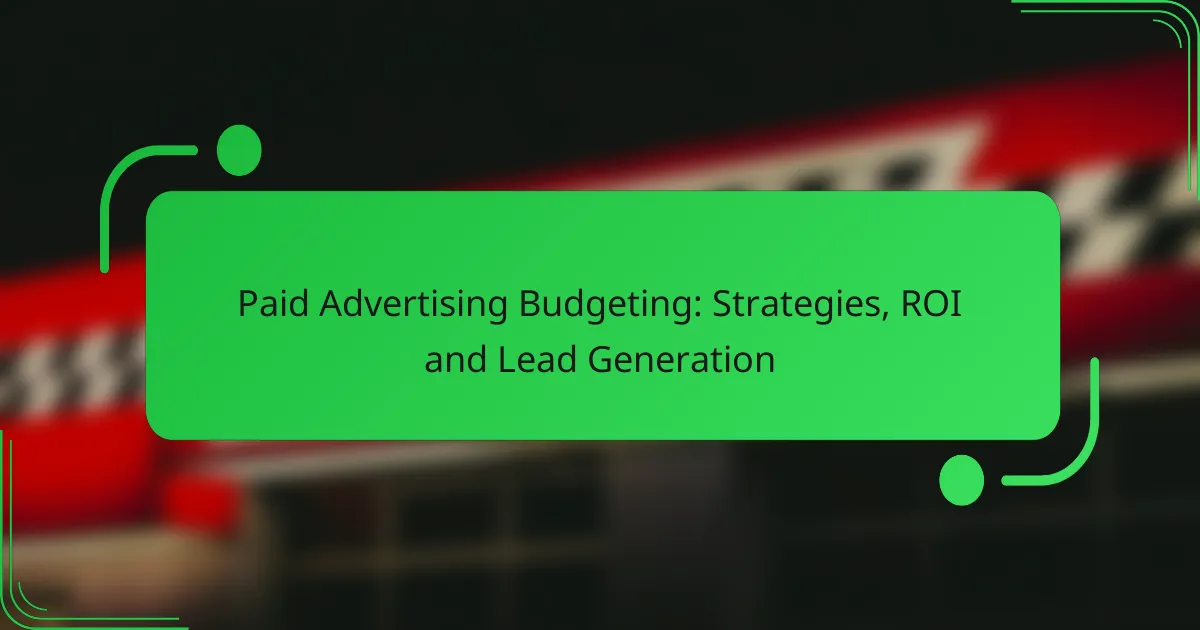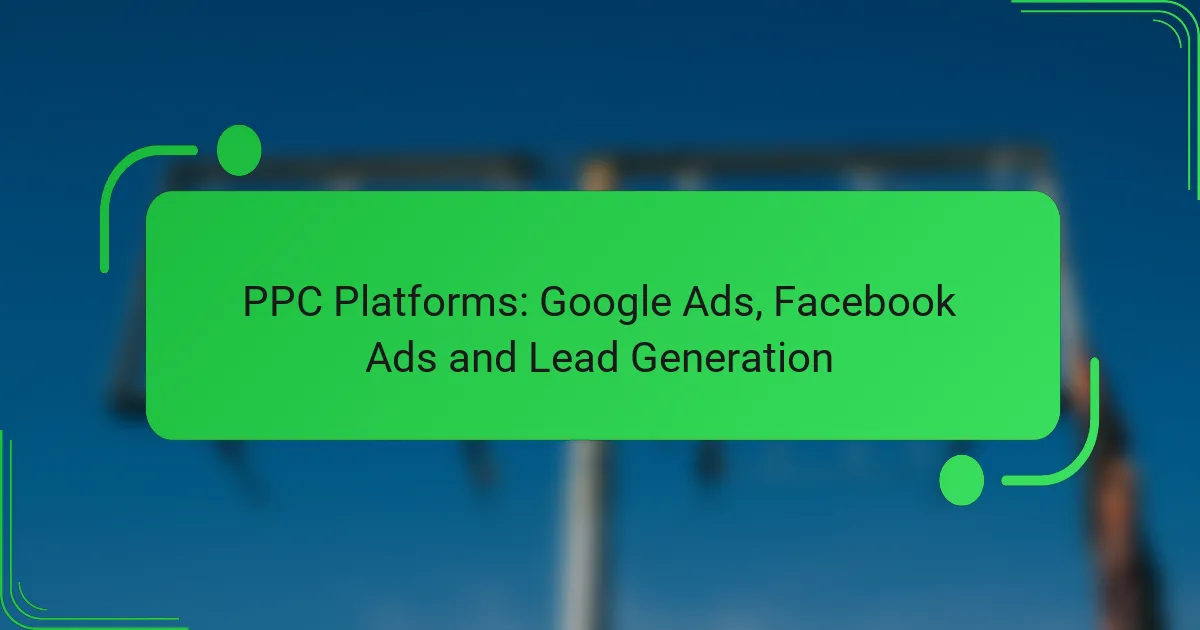Effective paid advertising budgeting strategies are essential for businesses aiming to maximize their return on investment (ROI) and generate valuable leads. By aligning advertising spend with overall growth objectives, companies can implement tailored methods that suit their unique goals. Understanding ROI and avoiding common budgeting pitfalls are crucial for optimizing campaign effectiveness and ensuring resources are used wisely.

What are effective paid advertising budgeting strategies?
Effective paid advertising budgeting strategies help businesses allocate their resources wisely to maximize returns on investment (ROI) and generate leads. These strategies include various methods that cater to different business models and goals, ensuring that advertising spend aligns with overall revenue and growth objectives.
Percentage of revenue method
The percentage of revenue method involves allocating a specific percentage of your total revenue to your advertising budget. This approach is straightforward and allows businesses to adjust their spending based on their financial performance.
Typically, companies might allocate anywhere from 5% to 15% of their revenue for advertising, depending on their industry and growth stage. For instance, startups may lean towards the higher end to establish their brand, while established firms might spend less.
Cost-per-acquisition (CPA) approach
The cost-per-acquisition (CPA) approach focuses on determining how much you are willing to spend to acquire a new customer. This method requires tracking the costs associated with your advertising campaigns and the number of customers gained through those efforts.
To implement this strategy, calculate your target CPA by dividing your total advertising budget by the number of new customers you aim to acquire. For example, if your budget is $10,000 and you want to gain 100 customers, your target CPA would be $100.
Competitive parity budgeting
Competitive parity budgeting involves setting your advertising budget based on the spending patterns of your competitors. This strategy aims to ensure that your business remains competitive in the market by matching or exceeding the advertising expenditures of similar companies.
To effectively use this method, research industry benchmarks and competitor spending. If competitors are spending 10% of their revenue on advertising, consider aligning your budget to maintain market presence and visibility.
Zero-based budgeting
Zero-based budgeting requires justifying every expense from scratch for each new period, rather than basing it on previous budgets. This method encourages a thorough analysis of all advertising initiatives and their effectiveness.
When using zero-based budgeting, start with a clean slate and evaluate the potential ROI of each advertising channel. This approach can help identify underperforming campaigns and reallocate funds to more effective strategies.
Incremental budgeting
Incremental budgeting involves adjusting the previous year’s budget based on expected changes in revenue and expenses. This method is simpler and often used by businesses with stable growth patterns.
To apply incremental budgeting, review last year’s advertising spend and make adjustments based on anticipated growth or market conditions. For example, if you expect a 10% increase in revenue, consider increasing your advertising budget by a similar percentage to support that growth.

How to calculate ROI for paid advertising?
Calculating ROI for paid advertising involves assessing the return generated from your ad spend relative to the cost incurred. A clear understanding of ROI helps businesses determine the effectiveness of their advertising strategies and optimize future campaigns.
Formula for ROI calculation
The basic formula for calculating ROI is: ROI = (Net Profit / Cost of Investment) x 100. In the context of paid advertising, net profit is the revenue generated from the ads minus the total cost of the ads. This formula provides a percentage that indicates how much profit is made for every dollar spent.
For example, if you spent $1,000 on an ad campaign and generated $5,000 in revenue, your net profit would be $4,000. Plugging these numbers into the formula gives you an ROI of 400%, meaning you earned four times your investment.
Importance of tracking conversions
Tracking conversions is crucial for understanding the effectiveness of your paid advertising efforts. Conversions refer to the actions taken by users as a result of your ads, such as making a purchase or signing up for a newsletter. By monitoring these actions, you can directly link ad performance to revenue generation.
Without proper conversion tracking, you may misinterpret data, leading to poor decision-making. Implementing tools like Google Analytics or Facebook Pixel can help you capture conversion data accurately, allowing for better optimization of your campaigns.
Tools for measuring ROI
Several tools can assist in measuring ROI for paid advertising, each offering unique features. Google Analytics is widely used for tracking website traffic and conversions, providing insights into user behavior and campaign performance.
Other options include HubSpot for inbound marketing analytics and SEMrush for SEO and PPC insights. These tools help you analyze data effectively, enabling you to make informed decisions about budget allocation and campaign adjustments.

What are common pitfalls in paid advertising budgeting?
Common pitfalls in paid advertising budgeting can significantly impact the effectiveness of campaigns. Miscalculations in costs, overlooking seasonal trends, and failing to target the right audience can lead to wasted resources and suboptimal returns on investment.
Underestimating costs
Underestimating costs is a frequent mistake in paid advertising budgeting. Advertisers often overlook additional expenses such as creative production, platform fees, and ongoing optimization. It’s crucial to account for these factors to avoid budget overruns.
A practical approach is to add a buffer of 10-20% to your estimated costs to cover unexpected expenses. This ensures that your budget remains flexible and can accommodate any necessary adjustments throughout the campaign.
Ignoring seasonal trends
Ignoring seasonal trends can lead to ineffective advertising strategies. Many industries experience fluctuations in demand based on the time of year, which can affect ad performance. For instance, retail businesses often see increased activity during holidays, requiring a shift in budget allocation.
To effectively manage your budget, analyze historical data to identify peak seasons for your industry. Adjust your spending accordingly, increasing your budget during high-demand periods and scaling back during slower times to optimize ROI.
Neglecting audience targeting
Neglecting audience targeting can result in wasted ad spend and low engagement rates. If your ads are not reaching the right demographic, the likelihood of conversion diminishes. It’s essential to define your target audience based on factors such as age, location, and interests.
Utilize tools provided by advertising platforms to refine your audience targeting. Regularly review and adjust your targeting parameters based on campaign performance data to ensure that your ads reach the most relevant potential customers.

How to optimize lead generation through paid advertising?
To optimize lead generation through paid advertising, focus on targeting the right audience, creating compelling ads, and continuously refining your strategies. Effective lead generation requires a combination of data analysis, creative approaches, and strategic adjustments to maximize return on investment (ROI).
Utilizing A/B testing
A/B testing involves comparing two versions of an advertisement to determine which performs better. This method allows you to test different headlines, images, or calls to action, enabling you to identify the most effective elements for your audience.
When conducting A/B tests, ensure you have a clear hypothesis and a sufficient sample size to achieve statistically significant results. Aim for a testing period of at least a week to gather enough data before making decisions.
Leveraging retargeting strategies
Retargeting strategies focus on re-engaging users who have previously interacted with your brand but did not convert. By displaying tailored ads to these users across various platforms, you can remind them of your offerings and encourage them to return.
Consider segmenting your retargeting audience based on their previous interactions, such as page visits or abandoned carts. This allows you to create more personalized ads, increasing the likelihood of conversion.
Implementing effective landing pages
Effective landing pages are crucial for converting leads generated from paid advertising. A well-designed landing page should have a clear value proposition, a straightforward layout, and a strong call to action that guides users toward conversion.
Ensure your landing page is optimized for mobile devices, as many users access ads through smartphones. Additionally, consider using testimonials or trust signals to enhance credibility and encourage visitors to take action.

What are the key metrics for evaluating paid advertising success?
Key metrics for evaluating paid advertising success include click-through rate (CTR), cost per lead (CPL), and conversion rate. These metrics provide insights into the effectiveness of your campaigns and help in optimizing advertising spend for better returns.
Click-through rate (CTR)
Click-through rate (CTR) measures the percentage of people who click on your ad after seeing it. A higher CTR indicates that your ad is relevant and engaging to your target audience, typically ranging from 1% to 5% for many industries.
To improve CTR, focus on crafting compelling ad copy and using eye-catching visuals. Regularly testing different headlines and calls to action can help identify what resonates best with your audience.
Cost per lead (CPL)
Cost per lead (CPL) calculates the total cost of acquiring a lead through your advertising efforts. This metric is crucial for understanding how efficiently your budget is being spent, with typical CPL values varying widely based on industry, often falling between $20 and $200.
To reduce CPL, consider refining your targeting options and optimizing your ad placements. Monitoring your CPL regularly allows you to adjust your strategies and maximize your return on investment.
Conversion rate
Conversion rate measures the percentage of leads that take a desired action, such as making a purchase or signing up for a newsletter. A good conversion rate often falls between 2% and 10%, depending on the industry and the specific goals of your campaign.
Improving conversion rates can involve enhancing landing page design, simplifying the user experience, and ensuring that your messaging aligns with user expectations. A/B testing different elements can provide valuable insights into what drives conversions.

How to align paid advertising with overall marketing strategy?
Aligning paid advertising with your overall marketing strategy involves ensuring that your ad campaigns support broader business goals and messaging. This alignment helps maximize return on investment (ROI) and enhances lead generation efforts by creating a cohesive brand experience.
Integrating with content marketing
Integrating paid advertising with content marketing enhances visibility and engagement. When ads promote valuable content, such as blog posts or videos, they can attract a more targeted audience and drive higher-quality leads.
Consider using paid ads to amplify high-performing content. For instance, if a blog post receives organic traction, a small budget can be allocated to promote it through social media ads or search engine marketing. This approach can yield a better ROI by leveraging existing interest.
To effectively integrate these strategies, ensure that your messaging is consistent across both paid and organic channels. Use similar language, visuals, and calls to action to create a seamless user experience that encourages conversions.



